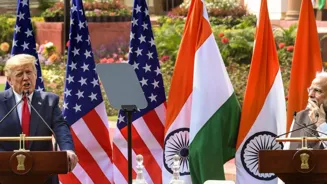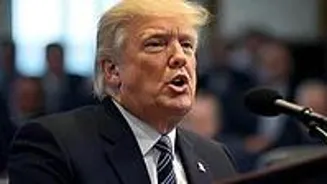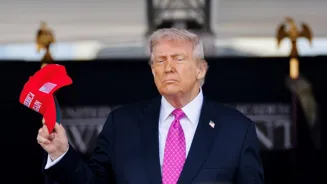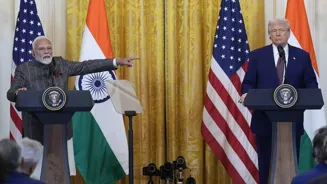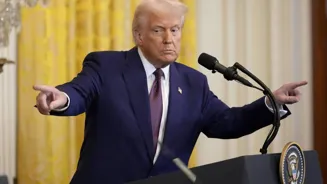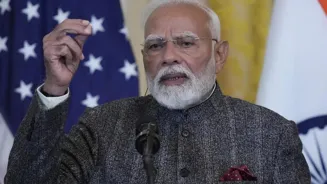The combined effect of two back-to-back 25 per cent tariffs imposed by US President Donald Trump has left India facing one of its most serious trade shocks in recent years. Together, the tariffs take the total
US import duty on Indian goods to 50 per cent, a rate unmatched for any other key US trading partner except Brazil.
According to economists cited by Reuters, the impact could be significant. Sonal Badhan, Economics Specialist at Bank of Baroda, told ANI: “We had initially priced in an approximate 0.2% impact on GDP growth due to the earlier 25–26% tariffs imposed by the US. The additional 25% hike will come into effect after 21 days… The overall impact on GDP growth could range between 0.2–0.4%, depending on the final trade agreement.”
In a separate note, Sakshi Gupta, Principal Economist at HDFC Bank, told Reuters: “While Trump’s order gives another 21 days for a deal to breakthrough, in case it does not, we will have to significantly lower FY26 GDP growth forecast to below six per cent, baking in a 40–50 bps hit.”
Apart from GDP, the pressure on employment and foreign exchange inflows is also mounting. MSMEs, which form the backbone of India’s labour-intensive export ecosystem, are expected to be the first to feel the pinch.
What Did Trump Announce, And Why Is India Being Targeted?
On Wednesday, US President Donald Trump signed an executive order imposing an additional 25 per cent tariff on Indian imports. This comes on top of a previous 25 per cent duty announced in late July. Combined, the total levy on Indian goods entering the US now stands at 50 per cent.
The new tariff round is explicitly linked to India’s continued purchase of Russian oil. Trump’s executive order accused India of “directly or indirectly” importing energy from Moscow, thereby undermining Western efforts to isolate Russia over its invasion of Ukraine. Trump had previously criticised India on social media, accusing it of profiting from Russian oil while disregarding the human toll in Ukraine.
The second set of duties will come into force on August 27, while the earlier 25 per cent tariff took effect on Thursday.
Which Sectors Of The Indian Economy Are Most Affected?
Roughly 60 per cent of India’s $91 billion exports to the United States are now subject to the full 50 per cent tariff. That’s over $54 billion in outbound trade facing steep cost escalation. Core affected sectors include textiles and apparel (worth over $10 billion), gems and jewellery (over $12 billion), shrimp (valued at $2.2 billion), leather goods, industrial chemicals, and machinery.
According to UBS, approximately $8 billion worth of Indian exports are in the highest risk category. These include products where pricing plays a crucial role in international competitiveness, such as ready-made garments, home furnishings, and chemical components.
Trade experts point out that Indian exporters already operate on razor-thin margins. The new tariff regime renders many shipments unviable, especially when competitor countries like Vietnam or Bangladesh are subject to duties in the range of just 19 to 20 per cent.
What Are Exporters And Industry Bodies Saying?
Exporters across sectors are sounding the alarm, with many already reporting cancelled or delayed orders. Colin Shah, MD of Kama Jewellery, told Mint that the effective 50 per cent tariff places Indian exporters at a 30–35 per cent disadvantage. He added that “many export orders have already been put on hold as buyers reassess sourcing decisions in light of higher landed costs,” and warned that MSME-led sectors may be unable to absorb the added costs.
Yogesh Gupta, MD of Kolkata-based seafood exporter Megaa Moda, spoke to PTI, highlighting the squeeze on India’s shrimp exports. He noted that Indian shrimp already attracts a 2.49 per cent anti-dumping duty and a 5.77 per cent countervailing duty. “After this 25 per cent, the duty will be 33.26 per cent from August 7,” he said, adding that India now faces far tougher competition from Ecuador, which faces only a 15 per cent tariff.
The Federation of Indian Export Organisations (FIEO) also flagged severe concerns. Its president, S.C. Ralhan, told ANI that nearly 55 per cent of India’s US-bound shipments are directly impacted. He warned that the 50 per cent tariff “puts Indian exporters at a 30–35 per cent competitive disadvantage” and said that “many buyers are now putting export orders on hold due to the higher landed costs.”
Ajay Bagga, a banking and markets expert, told ANI that the additional tariff effectively ends trade in some categories altogether. “India is now hit with 50% tariffs, but frankly, once it crossed 25%, it didn’t matter. Whether it’s 1,000% or 5,000%, there’s no trade possible anymore,” he said.
What About India’s Markets And Trade Balance?
While the impact on equities is somewhat muted due to the structure of India’s benchmark indices, sentiment has been affected. The Nifty 50 index derives only around nine per cent of its revenue directly from the United States, mostly through IT services, which are not covered by the new duties. However, the broader impact has been seen in currency markets. The Indian rupee has weakened, and currency volatility has risen, affecting foreign portfolio flows in the short term, according to Societe Generale.
India’s trade balance with the US remains substantial, with bilateral trade at $131.8 billion in 2024–25, including $86.5 billion in exports. The sectors now facing pressure contribute a large chunk of this total.
Are There Any Exemptions Or Relief Measures?
Some products have been excluded under Annexe II of Executive Order 14257. These include certain mineral substances, metallurgical ores, fuels, and pharmaceutical precursors. India’s electronics exports, including semiconductors, are also exempt, as are large US tech firms like Apple that operate manufacturing hubs in India.
Domestically, the Indian government is said to be considering support measures, including interest subsidies and export credit guarantees. While no formal relief package has been announced yet, official sources have indicated that options are being explored, especially if the 21-day negotiation window fails to yield results.
Is There Still Room For A Deal?
Despite the sharp rhetoric, India has not closed the door on talks. The 21-day delay before the latest round of tariffs takes effect is being seen as a sign that Trump may be open to a negotiated settlement. Trade experts also point out that the United States would stand to lose as well, particularly if India retaliates or redirects its exports to Europe or ASEAN economies.
The Bottom Line
Donald Trump’s 50 per cent tariff salvo has dragged India into a costly trade confrontation, one that threatens to wipe out billions in export revenue, trigger layoffs across MSMEs, and shave significant points off GDP growth. What was once a strategic economic partnership now stands at a crossroads, with the cost of miscalculation higher than ever.
